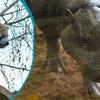With big eyes, golden fur and a fluffy tail, the distinctive hazel dormouse is a small mammal native to the British Isles that’s vulnerable to extinction. Due to milder winters and continued loss of woodlands and hedgerows, the UK population of these nocturnal rodents has halved since 2000 and continues to decline.
Paignton Zoo and its charity Wild Planet Trust have been working on the dormouse monitoring and reintroduction project for over 20 years. The long-running project involves monitoring wild dormouse populations, breeding a genetically diverse cohort and finding suitable reintroduction sites before quarantining and releasing the dormice into the wild.
The project is led by wildlife charity People’s Trust for Endangered Species, the National Trust, and delivered by the University of Cumbria’s Back On Our Map project, with other partners including the Common Dormouse Captive Breeders Group, Natural England, ZSL, the Morecambe Bay Partnership, the National Lottery Heritage Fund and Wildwood Trust.
Paignton Zoo’s collaboration in this project involved quarantining 20 dormice in their veterinary centre. Another 30 were quarantined at ZSL London Zoo.
Paignton Zoo’s veterinary team kept the dormice in quarantine for a total of 10 weeks, in which time they conducted frequent weigh-ins, checked their sexes and tested for parasites and diseases that could affect wild populations. The dormice were fed a selection of fresh browse similar to what’s available to them in the wild – a diet that is carefully monitored to allow experts to learn more about their preferred food. Head of Veterinary Services at Paignton Zoo, Ghislaine Sayers, is passionate about the project:
“Working with the dormice is one my favourite parts of my job. The collaboration between organisations and volunteers means we have managed to reintroduce hundreds of dormice over the years, with each release helping to preserve woodland habitats for dormice and teaching us more about the species as a whole.”
After a successful quarantine period, the dormice have now been released at the chosen release site. They’ll be fed by volunteers for around 10 days as they acclimate to the habitat before being fully released to explore the woodland, with continued feeding for as long as they require.
The captive-bred dormice will be monitored throughout their lives to keep track of their progress. Along with careful woodland management and annual releases, those involved in the reintroductions hope that their work will help to bring this native species back from the brink.
Related Members
-
News
 Belfast Zoo helps to bring Christmas joy to Children’s Hospital 19th December, 2025Belfast Zoo joined the Lord Mayor of Belfast, Councillor Tracy Kelly, on Monday (15th December) to help bring festive cheer to the Royal Belfast Hospital…
Belfast Zoo helps to bring Christmas joy to Children’s Hospital 19th December, 2025Belfast Zoo joined the Lord Mayor of Belfast, Councillor Tracy Kelly, on Monday (15th December) to help bring festive cheer to the Royal Belfast Hospital… -
News
 Colchester Zoological Society welcomes new arrivals 19th December, 2025This December, Colchester Zoological Society (CZS) welcomed some exciting new arrivals! A young male pygmy hippo, Mikolas, from Zoo Dvur Kralove…
Colchester Zoological Society welcomes new arrivals 19th December, 2025This December, Colchester Zoological Society (CZS) welcomed some exciting new arrivals! A young male pygmy hippo, Mikolas, from Zoo Dvur Kralove… -
News
.png?w=100&h=100&zc=1&f=jpeg&hash=8d175f93cde920c5ba23c8ea7f92e55a) Blog: Understanding the human side of zoos 16th December, 2025Why are zoo researchers increasingly looking to social science? Dr Nieky van Veggel explains the significance of understanding the human dimension…
Blog: Understanding the human side of zoos 16th December, 2025Why are zoo researchers increasingly looking to social science? Dr Nieky van Veggel explains the significance of understanding the human dimension…


